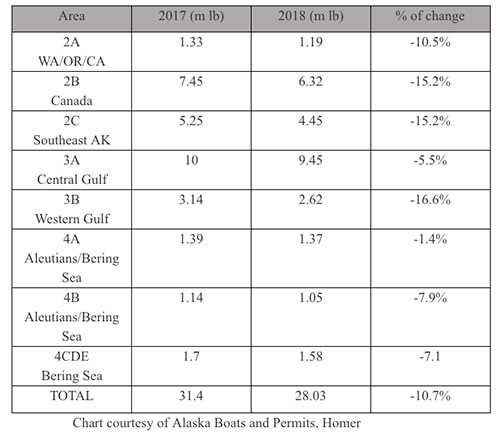|
Fish Factor Commissioners not able to agree on catch allocations for the 8 halibut fishing regionsBy LAINE WELCH
January 27, 2018
Following an increase in catches last year for the first time in several decades, the International Pacific Halibut Commission (IPHC) on Friday set a “suggested” coastwide catch for 2018 at 28.03 million pounds, a 10.7 percent reduction. Alaska’s share could be 20.52 million pounds, a drop of 2.1 million pounds from 2017. The numbers could decline further, as for the first time in memory since the IPHC began its oversight of the stocks in 1923, the six commissioners were not able to agree on catch allocations for the eight halibut fishing regions. Halibut catch limits are determined by summer surveys at more than 1,200 stations from Oregon to the Aleutians. “There was agreement that the general halibut stock is in decline, but no consensus on what the catches should be. Due to this impasse, the commissioners made suggestions for 2018 for their own countries,” said Tom Gemmell, executive director of the Juneau-based Halibut Coalition. “The Canadian's main issue on harvest reduction is that they do not agree with the U.S. on the distribution of the stocks. However, all agreed that stocks are down and that reductions are needed.” Gemmell added in email posts from the Oregon meeting. “The bottom line is both parties agreed on what we needed to do in terms of reductions, but couldn’t agree on how to get it done,” said IPHC chairman Jim Balsiger. “That’s an awkward place to be, but I don’t believe for a second that any of the commissioners did anything other than what they thought was best and what they were required to do by their own ideals as we try to get to a solution.” The impasse means that each country will set its own catch guidelines within recommended limits. “The need to adopt quotas outside the IPHC process may result in a delay to the March 24 opening date,” cautioned Gemmell. The U.S. halibut fishery will close on November 7. By all accounts, the five day meeting was “spirited but agreeable.” “The U.S. and Canada are good friends and neighbors and we do not consider the result a failure,” said attendee Bruce Gabrys in closing remarks that met with sustained applause. “Principled people sometimes disagree. I do not see our relations changing irrespective of what path the IPCH takes as we move forward. We thank the commissioners for their efforts.” Here are the 2018 suggested catches in millions of pounds compared to last year --
Total halibut removals in 2017 were 42.8 million pounds, up slightly from 2016. Of that, an estimated 26.6 million pounds were landed from commercial fisheries, 7.9 million pounds from recreational fisheries, 6 million pounds from bycatch, and 1.2 million pounds from subsistence. Gold mine comments due: Few Alaskans even know of it, but the world’s biggest “pure” gold mine is being planned by two Canadian companies near Crooked Creek, a tributary ten miles from the Kuskokwim River. The state plans to issue two draft permits for waste water discharges and waste management for the project and is taking comments now. According to KYUK in Bethel, one permit would allow 4,500 gallons per minute of treated wastewater to be dumped into Crooked Creek for the life of the mine. It also lays out the levels of contamination that would be allowed in the water. The other permit would regulate where other wastes from the mine would be stored. The draft permits also specify how that waste would be monitored. An environmental impact statement says that Crooked Creek and connecting tributaries are classified as essential fish habitat for five species of salmon and 12 other fish species. The Donlin mine, expected to operate for 27 years and yield nearly 40 million ounces of pure gold, would have a footprint of about 25 square miles. The open pit would be over two miles long, one mile wide and nearly 2-thousand feet deep. A 30 mile road would be built to the site and include housing and offices, an airstrip, a barge terminal at Bethel, a water treatment plant and a port on the Kuskokwim for offloading. To power the mine, a 40 million gallon tank farm would be built on site for diesel fuel to be delivered via a 315 mile pipeline from Cook Inlet, including along the Iditarod trail from Skwentna to Finger Lake. The pipeline would cross streams for anadromous and resident fish species at 77 locations. Waste materials from the mine, called tailings, would be stored in a manmade pond held back by a 475 foot main dam and a 345 foot high upper dam. The pond will cover 1,356 acres and hold 110 million tons of waste materials forever. Donlin expects to receive a final impact statement from the Army Corps of Engineers in March. State and federal agencies will then decide on more permitting. Comments on the water discharges can be made to the Department of Environmental Conservation through February 13. An all-natural, crab shell-based spray keeps game meat free from bugs, bacteria and contaminants. Game Meat Protector is the latest product from Tidal Vision LLC of Juneau that uses chitosan, a wonder ingredient extracted from the exoskeleton of crab shells. “It protects game meat out in the field from spoiling, and it also prevents bugs and insects from landing and burrowing into it,” said Craig Kasberg, Tidal Vision president. “It’s a way for hunters to preserve the quality of the meat as it is being harvested.” The spray contains only water, chitosan and citric acid. “It leaves a thin film on the game meat, and because of chitosan’s natural, anti-microbial properties and low pH citric acid, it preserves the quality,” Kasberg added. One eight-ounce bottle is enough to cover an entire large game animal, Kasberg said, and it also can be sprayed on game bags for extra protection. The game meat protector is sold on Amazon and will be carried later this year by major outdoor outlets. Learn more about chitosan and Tidal Vision’s other products at tidalvisionusa.com.
Representations of fact and opinions in comments posted below are solely those of the individual posters and do not represent the opinions of Sitnews.
SitNews ©2018 Stories In The News Ketchikan, Alaska
|
|||||



